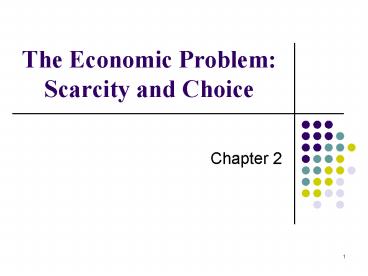The Economic Problem: Scarcity and Choice - PowerPoint PPT Presentation
1 / 24
Title:
The Economic Problem: Scarcity and Choice
Description:
inputs or resources Anything provided by nature or previous generations that can ... opportunity cost of every investment in capital is forgone present consumption. ... – PowerPoint PPT presentation
Number of Views:319
Avg rating:3.0/5.0
Title: The Economic Problem: Scarcity and Choice
1
The Economic ProblemScarcity and Choice
- Chapter 2
2
THE ECONOMIC PROBLEMSCARCITY AND CHOICE
3
THE ECONOMIC PROBLEMSCARCITY AND CHOICE
- capital Things that are themselves produced and
that are then used in the production of other
goods and services. - factors of production (or factors) The inputs
into the process of production. Another word for
resources.
4
THE ECONOMIC PROBLEMSCARCITY AND CHOICE
- production The process that transforms scarce
resources into useful goods and services. - inputs or resources Anything provided by nature
or previous generations that can be used directly
or indirectly to satisfy human wants. - outputs Usable products.
5
SCARCITY, CHOICE, AND OPPORTUNITY COST
- Opportunity Cost
- The concepts of constrained choice and scarcity
are central to the discipline of economics. - opportunity costs The best alternative that we
give up, or forgo, when we make a choice or
decision. - Education takes time. Time spent in the classroom
has an opportunity cost.
6
SCARCITY, CHOICE, AND OPPORTUNITY COST
- Specialization, Exchange, and Comparative
Advantage - theory of comparative advantage Ricardos theory
that specialization and free trade will benefit
all trading parties, even those that may be
absolutely more efficient producers.
7
SCARCITY, CHOICE, AND OPPORTUNITY COST
- absolute advantage A producer has an absolute
advantage over another in the production of a
good or service if it can produce that product
using fewer resources. - comparative advantage A producer has a
comparative advantage over another in the
production of a good or service if it can produce
that product at a lower opportunity cost.
8
SCARCITY, CHOICE, AND OPPORTUNITY COST
9
SCARCITY, CHOICE, AND OPPORTUNITY COST
- Capital Goods and Consumer Goods
- consumer goods Goods produced for present
consumption. - investment The process of using resources to
produce new capital. - Because resources are scarce, the opportunity
cost of every investment in capital is forgone
present consumption.
10
SCARCITY, CHOICE, AND OPPORTUNITY COST
- THE PRODUCTION POSSIBILITY FRONTIER
- production possibility frontier (PPF) A graph
that shows all the combinations of goods and
services that can be produced if all of societys
resources are used efficiently.
11
SCARCITY, CHOICE, AND OPPORTUNITY COST
12
SCARCITY, CHOICE, AND OPPORTUNITY COST
- Unemployment
- During economic downturns or recessions,
industrial plants run at less than their total
capacity. When there is unemployment of labor and
capital, we are not producing all that we can.
13
SCARCITY, CHOICE, AND OPPORTUNITY COST
- Inefficiency
- Waste and mismanagement are the results of a
firms operating below its potential. - Sometimes, inefficiency results from
mismanagement of the economy instead of
mismanagement of individual private firms. - The Efficient Mix of Output
- To be efficient, an economy must produce what
people want.
14
SCARCITY, CHOICE, AND OPPORTUNITY COST
15
SCARCITY, CHOICE, AND OPPORTUNITY COST
- Negative Slope and Opportunity Cost
- marginal rate of transformation (MRT) The slope
of the production possibility frontier (PPF).
16
The Law of Increasing Opportunity Cost
17
SCARCITY, CHOICE, AND OPPORTUNITY COST
- Economic Growth
- economic growth An increase in the total output
of an economy. It occurs when a society acquires
new resources or when it learns to produce more
using existing resources. - Economic growth shifts the PPF up and to the
right
18
SCARCITY, CHOICE, AND OPPORTUNITY COST
- THE ECONOMIC PROBLEM
- Recall the three basic questions facing all
economic systems - (1) What gets produced?
- (2) How is it produced?
- (3) Who gets it?
- Given scarce resources, how exactly do large,
complex societies go about answering the three
basic economic questions?
19
ECONOMIC SYSTEMS
- COMMAND ECONOMIES
- command economy An economy in which a central
government either directly or indirectly sets
output targets, incomes, and prices.
20
ECONOMIC SYSTEMS
- LAISSEZ-FAIRE ECONOMIES
- THE FREE MARKET
- laissez-faire economy Literally from the French
allow them to do. An economy in which
individual people and firms pursue their own
self-interests without any central direction or
regulation. - market The institution through which buyers and
sellers interact and engage in exchange.
21
ECONOMIC SYSTEMS
- Some markets are simple and others are complex,
but they all involve buyers and sellers engaging
in exchange. - The behavior of buyers and sellers in a
laissez-faire economy determines what gets
produced, how it is produced, and who gets it.
22
ECONOMIC SYSTEMS
- Distribution of Output
- The amount that any one household gets depends on
its income and wealth. - Income is the amount that a household earns each
year. It comes in a number of forms wages,
salaries, interest, and the like. - Wealth is the amount that households have
accumulated out of past income through saving or
inheritance.
23
ECONOMIC SYSTEMS
- Price Theory
- In a free market system, the basic economic
questions are answered without the help of a
central government plan or directives. - This is what the free in free market means the
system is left to operate on its own, with no
outside interference. - Individuals pursuing their own self-interest will
go into business and produce the products and
services that people want. Others will decide
whether to acquire skills whether to work and
whether to buy, sell, invest, or save the income
that they earn. - The basic coordinating mechanism is price.
24
ECONOMIC SYSTEMS
- MIXED SYSTEMS, MARKETS, AND GOVERNMENTS
- The differences between command economies and
laissez-faire economies in their pure forms are
enormous. - In fact, these pure forms do not exist in the
world all real systems are in some sense
mixed.































